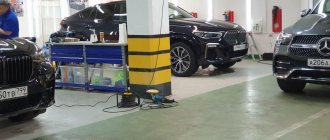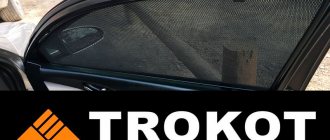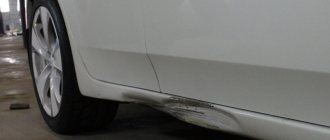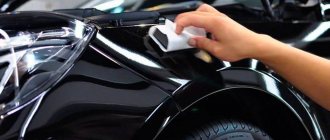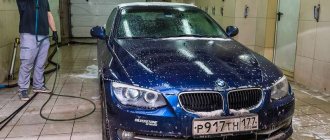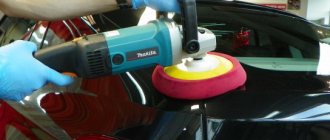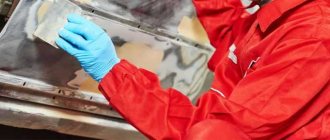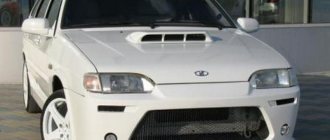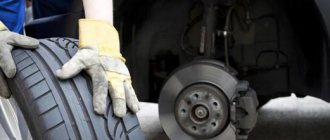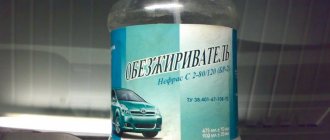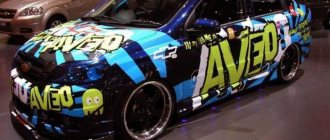U-Pol Raptor for the car - heavy artillery against external aggressors
Despite all its visual appeal, gloss, shine and excellent technical characteristics, auto enamel used by the modern automotive industry is not suitable for trucks, pickups and SUVs, which are often operated in quite extreme conditions. The usual coating on such cars is quickly damaged, the body becomes covered with abrasions and scratches, which not only spoil the exterior, but, over time, contribute to the development of corrosion and destruction of the metal. In order to reduce regular visits to a car service center to eliminate defects, there is an effective method - painting a car with raptor.
Durability and disadvantages of anti-gravel
Anti-gravel coating has a large number of advantages and is distinguished by durable results. However, this processing has several disadvantages.
The process of applying anti-gravel in a can
For example, a high price that is not suitable for every car owner. It also contains synthetic compounds that can harm the driver’s body when applied.
Thus, anti-gravel paint for cars is high-quality protection of the car from minor damage and the development of metal corrosion. It is important to approach the choice carefully and responsibly, since at a high cost you need to purchase a quality product the first time.
Packaging and equipment
This coloring agent is supplied for sale in packaging containing:
- four bottles (each 750 ml) with the main substance;
- hardener (1 l);
- anti-gravel gun designed to work with raptor;
- instructions with detailed recommendations for use;
- quality passport.
Sets may be black or off-white in color. Moreover, the latter can be transformed into any desired shade without much difficulty. To paint in different colors, 10% of the coloring pigment is added to the base.
How to prepare a surface for applying an anti-gravel compound?
It is important to properly prepare the surface before applying the anti-gravel coating. There should be no rust left. Sandblasting is perhaps the best way to prevent corrosion, but you can also use wire attachments on a drill and grinding wheels on an angle grinder. For more details, you can read the article “removing rust from a car body.” The surface must be washed, dried thoroughly and degreased.
Before spraying anti-gravel, you need to coat the welds and joints with a brush with a special joint sealant, and you can also apply primer with zinc.
It is necessary to cover adjacent surfaces using covering material and masking tape.
In case of application on a paint coating or acrylic primer, matting under anti-gravel can be done with sanding paper from p240 to p600.
Surfaces that are not subject to anti-gravel application must be covered with masking tape and covering materials.
In general, you need to prepare the surface as for painting.
Do-it-yourself anti-corrosion treatment of car thresholds
Re-processing of car thresholds is carried out independently; for this you will need: an anti-corrosion agent (Otrix, Rand, Novol, Car System, Roberlo, etc.), rust remover, sandpaper or a metal brush, a respirator and gloves
When buying an anti-corrosion agent, you should pay attention to all the little things: purpose, shelf life, application features
In the future, it is important to strictly adhere to the instructions on the packaging.
First, thoroughly wash the car from dirt and dry it. Try to provide access to all processing areas; if working with the bottom, the machine should be installed on a platform. Remove rust using sandpaper or a wire brush. Now treat the surface with a rust remover and let it dry thoroughly.
Let's start processing the purchased product. Apply it evenly to the car sills and other parts that require protection with this composition. All you have to do is dry the car for 24 hours
It is important to remember that you should not work near fire or heating devices, since, basically, all of the above products are highly flammable. In addition, in order not to harm your health, it is recommended to work with gloves and a respirator.
Properties, application and features of applying anti-gravel paint: we study thoroughly
Anti-gravel is a universal protective paint for the car and its elements. It is convenient in that it can be used by specialized services, service stations and ordinary car enthusiasts.
For independent use, it is best to use anti-gravel in cans, because... This form is convenient to use and does not require special skills.
Signs and causes of corrosion
Corrosion is one of the main causes of car body damage. The resistance of iron to corrosion is determined by its composition, that is, the presence or absence of alloying impurities in the metal.
Thus, the body material of Honda and Toyota cars has good anti-corrosion properties, and on the body of an Opel, traces of rust can appear even in a dry room.
Another cause of body damage is exposure to moisture from the atmosphere.
When operating a car in regions with a dry climate, the body is not in danger of rusting, but in the subtropics, on the contrary, the metal is most susceptible to corrosion.
Photo gallery: body damage due to corrosion
The paintwork of the body can also be damaged when driving on bad roads.
Sand, small gravel and stones hit the underbody and sills of the car, causing chips.
Moreover, the metal is negatively affected by the reagents used to treat roads in winter.
Various moldings and spoilers also contribute to the accumulation of dirt and moisture on the body, leading to the appearance of pockets of corrosion.
Signs of corrosion
First of all, corrosion manifests itself in places of scratches, chips and other minor damage to the body.
It does not pose a great danger if the problem is corrected in a timely manner.
The first sign of corrosion on the outside of the body is swelling of the paintwork (paintwork).
It usually occurs in places where the paintwork has poor adhesion to the metal and in areas with chips and microcracks.
When moisture gets under the paint layer, it peels off. A cavity is formed into which oxygen enters.
Washing the car in cold weather with warm water often leads to similar results.
Such areas are sanded down to bare metal, covered with a layer of primer and painted.
One of the main signs of corrosion on the body is swelling of the paintwork.
Corrosion can also appear in hard-to-reach places with poor ventilation, such as wheel arches, front fender pockets near headlights, lower parts of doors, interior floors, and sills.
Rust occurs as a result of the accumulation of moisture, dirt, sand, and the lack of ventilation aggravates the situation.
Depending on the nature of the damage, there are several repair options - welding, tinning, or epoxy putty.
Such work is quite labor-intensive and will require significant financial expenses.
It is worth noting that corrosion spreads more strongly in winter with irregular washing due to exposure to salt and other road reagents.
Keeping the car in a warm garage will not avoid this for the following reasons:
- In the heat, condensation accumulates on the body and in hard-to-reach places.
- When moisture evaporates in a warm room, corrosion accelerates.
Therefore, in winter it is recommended to keep the car under a canopy in the open air.
Outdoors under a canopy the likelihood of corrosion is minimized
Types of corrosion
The following types of corrosion are distinguished:
- electrochemical is the most common. Metal oxidation begins when moisture gets on the body. This corrosion develops most intensively in hard-to-reach, unprotected places with poor protection, where moisture and dirt accumulate;
- atmospheric is divided into the following types: dry - the metal is destroyed as a result of a chemical process in the absence of moisture. The surface quickly becomes dull (oxidized), and its destruction begins;
- damp - the cause is a thin layer of moisture. The higher the humidity, the faster the metal oxidizes. The areas of the body that are most susceptible to rust are those with damaged paintwork (cracks, crevices;
- wet - appears as a result of fog, rain, etc. The thickness of the wet film can be 1 mm.
With electrochemical corrosion, metal oxidation occurs as a result of moisture entering the body
Application of anti-gravel on the sills and rear panel
Greetings, car enthusiast on the RtiIvaz.ru blog!
Today we’ll look at Vlad ShchCh’s video where he shows the step-by-step process of preparing and applying anti-gravel to the sills and rear panel of the car. The body repair master laid out the process of preparing the sills and rear panel of the car for applying an anti-gravel coating for protection during operation.
Our example considers painting with anti-gravel. A layer of soil has been applied to the thresholds, which has already dried and you can move on, that is, prepare the thresholds for applying “anti-gravel”. Anti-gravel coating is a fairly simple operation, but it requires certain knowledge when performing the work. So, before applying the coating, it is necessary to “knock off” the gloss from the ground for better adhesion to the anti-gravel coating.
In addition to the fact that it is necessary to remove the gloss from the ground, you also need to cover the problem areas with sealant, but in our case there are no such places on the thresholds, and therefore we skip this operation. The sealant will need to be applied to several points on the back panel, since welding work was carried out there, which are problem areas.
Tools and materials required for work:
- Scotch-brite – for removing gloss from the ground;
- Anti-silicone and paper napkin - for degreasing the surface before applying anti-gravel;
- Painting tape - for covering car parts that are not intended for painting with anti-gravel;
- Polyurethane joint sealant (in cans or tubes) – for sealing seams and other problem areas;
- Short bristled brush for applying sealant;
- Anti-gravel (gravitex);
- Anti-gravel gun;
- Solvent “647” for cleaning tools after work, this is washing the paint gun, brush and other things.
If there are no marks on the prepared surface, then the material that will be applied will simply peel off from the painted surface during subsequent high-pressure washing or when exposed to compressed air. Without the risk, there is no proper adhesion of the paint.
When the car is already prepared for painting, that is, it is covered with film up to the thresholds, then you need to rub the surface carefully so as not to damage the film itself.
Instead of Scotch Brite, you can use sandpaper No. 220-320 and a block to level the surface from previously applied primer. In our case, nothing needs to be leveled on the thresholds, and we use Scotch-Brite. In addition, if there are any small defects on the thresholds, the anti-gravel will simply hide them when applied.
Let's move on to the back panel. Here we also carefully rub the gloss, trying not to leave untreated areas. Scotch Brite is very convenient for getting into hard-to-reach places, which cannot be done with a power tool or sandpaper. Video: In the video, Vlad showed that the surface after treatment became matte, that is, the gloss was knocked off and a small mark was applied. On gloss without treatment, as mentioned above in the article, the coating will not stick and will quickly “slip”.
What do you need to have to process thresholds yourself?
For anti-corrosion treatment of thresholds you will need:
- anti-corrosion composition;
- rust modifier;
- wire brush and abrasive;
- water;
- degreaser;
- rags;
- masking tape;
- protective equipment due to the toxicity of fumes (gloves, respirator, clothing that completely covers the skin, goggles).
Before starting work, be sure to read the instructions and fulfill all requirements. If it is not possible to carry out work in a warm garage or box, move it to the summer. In winter and autumn, such treatment is carried out in a warm room. Be sure to wash and dry the car before the procedure.
What is important to know
Experts do not recommend purchasing inexpensive products in the hope of saving money. As a result, for a small amount you can get a product of dubious quality. It is better to choose among well-known brands that have already proven themselves well among car owners.
The main disadvantage of anti-gravel paint can be considered the content of various synthetic compounds in its composition - they can be harmful to health. That is why it is best to use personal protective equipment when working with this product.
How to apply Gravitex correctly
Its service life and efficiency depend on the correct application of the composition to the car body. Application technologies will differ depending on whether there is damage (chips, cracks, scratches) on the surface being treated or not.
How to apply non-paintable Gravitex to a surface without chipping
In order to treat a perfectly flat car surface with Gravitex, you will need the product itself, a degreaser, clean rags, masking tape and film (or paper) to protect the area that is not intended to be treated.
Please note: If the surface is not chipped, the best option would be to apply unpainted Gravitex to it, which is initially body-colored or colorless. The process of applying Gravitex will take place as follows: The process of applying Gravitex will be as follows:
The process of applying Gravitex will be as follows:
Prepare the surface on which the product will be applied. To do this, remove any dirt from it and dry it thoroughly. Make sure that there are no chemical deposits left on the surface from detergents, and that there are no grains of sand or dirt; Degrease the surface by applying a degreaser using a rag; The area that will not be treated with Gravitex is covered with masking tape, film (or paper); Next, Gravitex is applied in an even layer. Depending on the chosen composition option (aerosol or liquid), the details of the application technology will differ
It is important to apply it in a thin, even layer; After applying one layer, wait until the composition dries and apply a second layer; Next, wait until Gravitex dries, then remove the protective materials.
Important: It is recommended to operate a car to which Gravitex has been applied no earlier than 24 hours later.
How to apply paintable Gravitex to a chipped surface
It is much more difficult to apply the product to a body that has defects. In this case, you should choose paintable Gravitex, which will need to be painted over after application.
Please note: It is ideal to use a computer paint selection method to match the color as closely as possible to the body color. To apply Gravitex to a chipped surface, you will need more tools: sandpaper, putty, primer, body anti-corrosion treatment, paint, rags, masking tape and film (or paper). To apply Gravitex to a chipped surface, you will need more tools: sandpaper, putty, primer, body anti-corrosion treatment, paint, rags, masking tape and film (or paper)
To apply Gravitex to a chipped surface, you will need more tools: sandpaper, putty, primer, body anti-corrosion treatment, paint, rags, masking tape and film (or paper).
The Gravitex application process is as follows:
- First you need to clean the surface from dirt and dust;
- Next, use masking tape and paper to cover the body parts to be painted;
- With the help of sandpaper, body elements that have defects are polished - dents, chips, scratches, areas with corrosion, and so on;
- The surface is degreased;
- Using putty, existing dents are repaired;
- An anti-corrosion agent is applied to defective body elements;
- The primer is applied, after which you need to wait for it to dry;
- Next, the grinding stage goes through again to level the surface, after which the surface is degreased;
- Next begins the stage of applying Gravitex. The product is applied in one even layer, after which you need to wait for it to dry and apply a second layer;
- Leave the car for 24 hours for the Gravitex to dry completely;
- The final stage is applying paint.
After applying the paint, it is also important to let the car “dry”. Depending on the type of paint applied, this may take different times, follow the instructions for the paint
How to properly treat with anticorrosive
To independently treat the underbody of your car with a protective coating, you will need:
- degreaser (you can use regular acetone or white spirit);
- tools for scraping off dirt and already formed corrosion (screwdrivers and wire brushes);
- sandpaper;
- sprayer or brush for applying a protective composition;
- a mirror so that you have the opportunity to examine all parts of the bottom.
Next, you will need to prepare a homemade composition, which may consist of the following materials:
- soundproofing material (for example, Body 950), of which 400 milliliters will be enough;
- any means to protect the bottom from mechanical damage;
- vibration-absorbing mass with anti-corrosion properties (for example, “Cordon”);
- directly the anticorrosive agent itself, of the brand you have chosen;
- ordinary plasticine;
- brown cannon lard;
- sealant or any other similar that can be used to fill gaps and cracks.
Once you have prepared everything necessary for processing, you need to perform the following steps:
- Remove insulation and old soundproofing materials.
- Remove the wheels.
- If you are treating interior areas, place protective covers on the seats and dashboard.
- Wash the car thoroughly and wait until it is completely dry (you can use warm compressed air to speed up the process). For washing, a regular soap solution supplied under pressure is suitable.
- Sand the surfaces with sandpaper or a rubber sanding block to remove corrosion.
- Degrease the under-wheel area and treat it with sound-proofing material.
- Mix cannon fat, plasticine and vibration-absorbing composition. Heat this mixture in a water bath and wait until it turns black, after which the liquid can be removed from the heat.
- Apply the resulting composition with a brush to the underside of the car in a thick layer.
- Treat the screws of the removed parts with anti-corrosion agent, then wait 3-4 hours and install them in place.
In order for everything to be done correctly, it is recommended to treat surfaces in the following order:
- wheel arches;
- fasteners and bolt connections;
- suspension;
- inner part of the hood;
- ball joints;
- welds.
After treatment, do not use the car for 24 hours.
Corrosion control methods
If a driver finds rusty sills on his car, what should he do first? Let's look at this further:
- Conduct an inspection to determine the extent of damage.
- Buy suitable car anti-corrosion agent, anti-gravel agent, tools and materials for repairs.
- Choose a method of repair and further protection of the threshold from destruction.
Drivers have several ways to repair and protect the threshold. Among the most productive and economical are threshold priming and anti-gravel treatment. It is necessary to monitor the condition of the threshold regularly, external inspections of the body are carried out every month, and full diagnostics on a pit or lift are performed once every 12 months.
The maximum service life of bitumen mastic, which remains the most reliable material for treating external surfaces, is 12-18 months, provided there is no mechanical damage.
Padding
Using a primer with a high zinc content cannot completely protect the threshold from rust. The material does not have 100% insulating properties. The layer between the paintwork and the metal of the threshold has a hygroscopicity of 4-8%. This means that moisture still penetrates through the material.
Priming remains a reliable method when used in conjunction with paraffin anti-corrosion agents and rust inhibitors. The main rules when applying primer:
- The metal must be cleaned until white and degreased.
- The primer is applied to a dry surface.
- Bitumen mastic is applied to a completely dry primer.
It is recommended to begin work on protecting the threshold by inspecting the lower edge of the door.
Lamination
Lamination is considered a fairly reliable means of stopping corrosion of car thresholds, but only if the rust source is completely preserved. When making repairs on their own, drivers cannot always completely remove primary rust from a part. When there is no serious damage, there is no need to cook the threshold, but there is no way to clean noticeable rust. In this case, corrosion inhibitors are used, liquid anticorrosion agents, which, after drying, create a durable, hermetically sealed film.
Lamination is the installation of a transparent film on the outer part of the threshold. An armored vinyl or polyurethane film can be used; there is an option to spray the laminate with an aerosol. The film will not only protect the metal from destruction, but will also protect the paintwork from small chips when hit by gravel, and will give the car a well-groomed appearance. Removing the film takes up to 30 minutes.
External processing
External protection of thresholds involves the use of anti-gravel and anti-corrosion compounds and the installation of overlays. The process should begin with removing the old paintwork and stripping the metal. If there are no traces of rust, the body is sanded with emery.
For external treatment, dense anticorrosives and bitumen mastics are used, which are resistant to temperature changes and retain minimal elasticity in their inner layer. The reliability of the anticorrosive protective layer depends primarily on the quality of the preparatory work. The best mastics for external panels:
- LIQUI MOLY Wachs;
- Body 930;
- Dinitrol 479;
- Tectyl Bodysafe.
Dense compositions have minimal thickness and tightness, and do not allow rust to form under the primer layer.
Internal processing
For internal treatment of the threshold, which is structurally a hollow box, paraffin and oil anticorrosives are used, they are sprayed with an aerosol or poured into the internal pocket through technological holes.
During repairs, it is recommended to carry out simultaneous internal treatment of the wheel arches. The parts are located nearby and when one of them rots, corrosion quickly spreads to the other. The best anticorrosion agents based on oil and paraffin for internal cavities:
- Dinitrol ML;
- Tectyl ML;
- LIQUI MOLY;
- VELV Movil-5E.
Oil compositions are intended to preserve and remove the first pockets of rust; the service life of the composition is up to 1 year.
Which anti-gravel is better
This material comes in several types:
- Varying in texture (smooth and textured);
- Anti-gravel, allowing subsequent painting;
- Anti-gravel used on certain elements of the car.
The textured composition is better suited for application to plastic. Before purchasing, you should study the list of parts for which a particular product is suitable.
The composition is produced in 3 versions:
1. Anti-gravel spray in cylinders.
- Hi-Gear CHIP STOP PROTECTOR CLEAR. Requires application in several layers. It has a transparent color, which allows it to be applied without compromising the aesthetic characteristics of the car. Creates a reliable protective film, but can be easily removed if necessary. Disadvantages include high cost;
- BODY 950. The manufacturer produces 3 colors: black, white and gray. These are Greek products that have long proven themselves in the car market. After application it can be painted. BODY 950 is one of the most popular in Russia, along with BODY 900 and BODY 933 (the last 2 cannot be painted);
- Liqui Moly 6109. Professional product. Available in black only. This composition is one of the best anti-gravels on the market, which significantly affects its price. It is permissible to use the composition on any surfaces, but it must be taken into account that it paints them black. The product itself is quite economical, made on the basis of polyurethane resins;
2. Anti-gravel for a pistol. Less convenient than balloon. Sometimes it has to be diluted with solvents. This application option is more difficult, but also more professional.
3. Anti-gravel in jars. Apply with a roller or spray gun. Earned a large number of positive reviews, although not as widespread as the previous 2.
How to effectively protect car sills from corrosion? (Photo and video)
Many motorists believe that it is important to protect the outer part of the body from rust, for example with an anti-gravel coating, but the reality is that, basically, the sills rust from the inside. And no matter how well they are treated on the outside, without proper treatment, they will rot to holes in a few years
External processing.
As was written in the introduction, external processing is not as important as internal treatment, but nevertheless, it is the external part of the threshold that determines the appearance of the car. And in order to improve it, many motorists install plastic body kits. The appearance is supposedly better and the chips are not visible. Colleagues are a huge mistake. A non-standard body kit harms the threshold more than the lack of paint!
See what happens under the plastic door sills:
The fact is that dust inevitably accumulates under the linings; naturally, in our climate, the dust collects water and does not dry out most of the time, and with every change in temperature or driving over uneven surfaces, the dust collected under the lining strips off the paint! The result is that the threshold rots not only from the inside, but also from the outside.
We agreed - we will remove the non-standard sill trims...
The thresholds themselves, over time, lose their paint due to the abrasive effect of road dirt. We already have a separate article on our website about how to paint thresholds; we won’t repeat it.
To reduce the abrasive effect of road dirt, be sure to install mud flaps on the front wheels. With mudguards, the paint on the thresholds and arches will last several years longer, and most importantly, the amount of water getting inside the threshold will be reduced.
The author of the article had a case - a Volga 3102, which had been used all its life in Volgograd, but had lived for one winter in St. Petersburg, and by coincidence, the Volga was without one front mudguard, came to overcook the threshold, so - the threshold and the box on the side without the mudguard were ROTTEN, while while the threshold on the other side did not even require overcooking of the lining, although it had damage from impact and chipped paint.
We agreed - we will definitely install mudguards on the front wheels.
To summarize, on the outside:
- removing non-standard linings
- Be sure to restore the factory paintwork
- Be sure to install mudguards
Internal processing.
The network is full of recommendations on materials for treating hidden cavities, from pushsal, mining and Movil to modern corrosion inhibitors, we will also give our recommendations, but before treating the threshold, it must be washed! This is done very simply - the plugs are removed from both sides and the threshold is washed with plenty of water. Here's a video using an example of a 124 Mercedes:
But we shook out so much sand when we were digesting the thresholds on the Mazda 3 2007:
We agreed - before treating anything hidden from the cavity for rust, be sure to wash the threshold and dry it for several days.
Mining is the cheapest option.
The tradition of pouring waste into the thresholds dates back to the times of the USSR, and indeed, 2-3 liters of waste into the threshold at each oil change extends its life by 5-10 years!
They write online that you can’t pour mining, it will accelerate corrosion, etc. - nonsense! Working out helps, the author of the article was a 1993 Volga. which had factory thresholds in 2021 because it was spilled with drainage at every oil change. Think about it - the most rotting Volga (31029) had its original thresholds 25 years after production, only thanks to development!
Extraction perfectly impregnates rust and blocks the access of air to the metal, respectively, the rate of decay slows down significantly.
The myth that working out accelerates corrosion, and if you pour oil into the sills, then only fresh oil, was started by marketers (you have to sell anti-corrosion compounds)…
The development is not without its drawbacks:
- It is harmful to health because... It is unknown what it is made of, and what additives were used in it, and what it washed out of the engine!
- The waste sometimes has a rather foul odor, which takes a long time to dissipate.
- Cavities need to be drained at least once a season.
For those interested, crude oil is an excellent substitute for waste, is much less harmful to health, and is much less easily washed off with water, but it is quite difficult to get.
Movil and pushsalo are a cheap option.
Both were developed a long time ago. Pussalo has been used for more than 200 years to preserve guns and shells, and Movil (Moscow - Vilnius) was developed as an anti-corrosion agent in the early 70s.
Both are petroleum derivatives: pushsalo - thickened petroleum oil, Movil - a mixture of lithol, motor oil, drying oil, kerosene and corrosion inhibitors. Both anticorrosives have the same principle of action - to limit the access of oxygen to the treated surface.
If Movil is relatively liquid, and like a waste product, it wets the rust (albeit worse). That gun lard, at normal temperatures, can be cut with a knife and it is only applied hot, which is not always possible in anti-corrosion treatment, so using it to protect thresholds is nonsense, but covering the bottom for preservation, on top of mastic, for a long period of parking is quite option.
Movil is an expensive alternative to mining. Because it smells just as bad and has just as bad an effect on the health of those who smell it.
Movil also needs to be updated periodically because Over time it dries out and cracks.
Modern anti-corrosion agents...
Naturally, over time, manufacturers have improved anti-corrosion agents, and in addition to the “collective farm methods” given above, there are quite modern compositions:
Most of them are analogues of Movil, but differ in drying speed and corrosion inhibitors. The most important advantage is that they can be applied less frequently, and they are more expensive to purchase, but they also require updating less often. Agree - most people drive a car for 2-3 years and it is much more profitable to carry out anti-corrosion treatment once with high-quality materials than to update the Movil every year for money.
We agreed - the protection of hidden cavities consists of 2 stages:
- Washing the threshold from dirt from the inside
- Treatment with anti-corrosion compound.
That's all for me today. If you still have questions about how to protect car sills from corrosion, or if you want to tell us about your experience of using anti-corrosion compounds, write comments.
Anticorrosive treatment of the underbody and hidden cavities of the body
Publication date: April 19, 2021. Category: Automotive equipment.
The supporting element of each car is, of course, the body and its bottom, which serves as the so-called platform on which the main elements of the car are located. That is why, when purchasing a used car, the buyer first of all pays attention to the bottom, since if it is in a deplorable condition, then there is no point in spending effort on repairing it.
Thanks to modern technologies and the latest developments, today cars come off the assembly line with reinforced bodies, which are covered with special materials, such as fiberglass or polymers. Unfortunately, such treatment cannot yet be found on all cars, especially for domestic models, the body of which is made of ordinary metal, which is susceptible to the harmful effects of corrosion. But, even if you own a foreign car, this does not mean that at some point you will not find yourself with a “bare bottom”. The fact is that some manufacturers, in an effort to reduce the cost of a car, prefer not to spend money on additional processing; as a result, consumers get a “pig in a poke.”
Corrosion progresses quickly and can affect the most important and expensive elements of the car in a matter of months, which, in turn, will affect the operation of the chassis, suspension and other elements. If you carry out diagnostics and treatment in a specialized car service at least once a year, then there is nothing to worry about, but if you prefer to do everything yourself, then be sure to carefully check all possible places where rust occurs.
Classification
Depending on the chemical composition and specific application, anti-corrosion agents for cars are divided into several categories. Before deciding which anticorrosive agent is best for a car, you should carefully study what the instructions say about its features.
When deciding which anti-corrosion agent is best, first of all keep in mind that the products differ in different parameters, one of which is the place of their application
Based on their chemical composition, such products are divided into the following categories:
- bitumen mastics - they are made from synthetic resins, they are designed to protect the surface of the machine from external mechanical influences, and thus ensure the preservation of metal surfaces. The thickness of bitumen mastic application is 250–400 micrometers;
- substances based on polyvinyl chloride and rubber - they are the most durable and reliable. This category is usually used in factory conditions;
- liquid plastic - it is recommended to use it as an additional means, since it is not characterized by reliability and durability;
- non-drying oil compositions - they remain in a liquid state throughout their entire service life. They are characterized by good filling properties, preserving all pores and cracks in the material.
- paraffin and wax compounds - form an elastic film that protects the surface from rust formation. Shown high resistance to strong temperature changes.
Usually made on the basis of oil or paraffin. Are in a liquid state
What does anti-gravel coating provide?
You need to understand that different manufacturers make anti-gravel compounds of different quality and composition. High-quality modern compounds do not contain bitumen and have the following properties:
- good corrosion protection
- resistance to non-aggressive acids and salts
- high resistance to impacts from small stones
- reduces noise
- reduces vibrations
- provides protection against engine oil, water and fuel
Repair technology for fixed thresholds
Before starting repairs, the car must be raised. If metal retraction or dent repair using welding is used, it is necessary to disconnect the negative terminal from the battery and drain the fuel.
Leveling a dent using a reverse hammer or plotter in steps:
- Remove the interior floor covering.
- Using a grinder, cut off part of the paintwork and clean out the dent with sandpaper.
- Spot weld rings or hooks onto the surface of the dent.
- Using a hood, carefully straighten the metal.
- Clean the weld areas and prime the surface. Automotive putty is applied if the surface of the part remains uneven after drawing: the putty hides blemishes.
- Treat the surface with anti-gravel protection.
- Apply auto enamel.
You can level out the dent using a steel hook and a straightening hammer. A corner is cut in the center of the dent, a hook is inserted into the hole, and the metal is straightened with muscular effort. After stretching, the tenderloin area is cooked.
Repairing a part with corrosive wear using epoxy resin:
- Use sandpaper to remove old paint and primer and bring the metal to a shine.
- Treat the part with a rust converter and let it dry.
- Degrease the surface.
- Mix epoxy glue with hardener, add aluminum powder to the composition.
- Impregnate a fiberglass patch with epoxy resin and apply it to the area to be restored. Apply as many layers of fiberglass as needed to seal the corrosion hole.
- Roll with a roller, expelling air and leveling the surface.
- Epoxy resin dries in 24 hours. After complete drying, clean the surface with sandpaper, treat with primer, and putty.
- Treat the surface with anti-corrosion agent and paint at the final stage.
Such repairs can only be used as a temporary measure: repairs with epoxy and fiberglass will extend the life of the part by a maximum of 6 months. Afterwards, the driver will need a full replacement of the body element or repair by welding.
Application process
Do not forget to decide on the choice of color, since anti-gravel can be gray, black or white, as well as transparent. There are manufacturers offering multi-colored anti-gravel mixtures. This way you can choose a product depending on the color of your car.
I propose to talk specifically about the thresholds, since it is extremely difficult to process the same bottom. For a beginner, it’s better to start simple.
In addition to anti-gravel, you will need:
- metal brushes with varying degrees of hardness;
- clean rags;
- newspapers;
- scotch;
- sandpaper;
- personal protective equipment.
Be sure to complete the last point, since this is beneficial for the car, but for you it is a serious threat to health.
If everything is ready, you can start working. It includes several stages.
- Preparation. It is carried out before applying the drug. Everything is simple here. Bring your sills back to their divine glory by removing dirt, traces of oil and other contaminants. Anti-gravel coating will be useless if applied to a dirty car. Plus, dry the thresholds completely before applying the product. There should be no moisture on them.
- Using metal brushes or sandpaper, the surface of the car sills is cleaned of rust, peeling paint, and so on. Do the same with shagreen (the painted surface resembles an orange peel).
- Clean rags, newspapers and regular stationery tape will be needed to protect against the anti-gravel agent getting into areas of the car located near the threshold. This way you will not get the car dirty and will minimize the cleaning procedure after work.
- Next, rely strictly on the instructions of the product you purchased. Each manufacturer may have its own requirements, rules and recommendations. There are no universal tips, since mixtures are produced in different forms and with different compositions. Apply anti-gravel to the treated prepared surface.
- Wait for the applied layer to dry. This usually takes from a few minutes to a couple of hours. I repeat, it all depends on the specific product.
- Then you need to process the surfaces a couple more times. Some mixtures are advised to be applied in 2 layers, for others effectiveness is achieved with 3-4 layers. After each new layer, be sure to wait for the product to dry.
- When the last layer is applied, wait again. Just now make sure that the composition has completely frozen and not just dried out a little. This may take 3-4 hours.
Let's go back a little. If you have taken an anti-gravel mixture, but its anti-corrosion properties are not the most powerful, before the very first application of anti-gravel, you can treat it with a high-quality anti-corrosion agent.
Nothing complicated at all. You just need to choose a high-quality composition, allocate time for work and follow the instructions.
Thank you for your attention! I hope you liked the material and found it useful. You can write about this in the comments. Special thanks to those who remember to subscribe and bring their friends to us!
( 1 ratings, average: 5.00 out of 5)
Small stones flying out from under the wheels of a car are a real pain for a motorist, since it is because of them that scratches appear on the paint. Considering the state of our roads, we have to deal with such troubles quite often. In the future, even minor scratches can cause corrosion. To protect your “swallow” from abrasions, you should use an anti-gravel coating that will preserve the car’s luxurious appearance.
The best anti-corrosion agents for the underbody
Anticorrosive for the underbody of a car primarily protects the metal surface from electrolytes. It must be elastic, durable and withstand climatic conditions. Most often, bitumen mastic is purchased, which protects against mechanical stress and does not collapse when colliding with obstacles. Corrosion-inhibiting materials are also commercially available.
Runway
The products in this line include a polymer mixture that reliably protects the coating. The bottom becomes resistant to any mechanical damage and rust. You can buy such an anticorrosive agent inexpensively at any car dealership. Particularly popular is galvanic coating, which contains zinc. A chemical reaction with a mechanical surface forms a strong, gray film. The material is also used when priming the body before painting. This is a good option for cold winters and long frosts.
Advantages
- Low price;
- Effectively protects against corrosion;
- Protects for three years;
- Dries instantly;
- Sold in any stores.
Flaws
- Poor insulation from noise;
- Low quality aerosols come across.
The composition is often purchased in northern cities. Buyers are attracted by the affordable price and acceptable quality of the product.
Valvoline
Tectyl Bodysafe is considered the best product of this company. This anti-corrosion agent contains zinc, which can withstand harsh operating conditions. The composition of medium viscosity is packaged in buckets with a capacity of 1 and 5 liters. The product is easy to apply and penetrates into crevices without problems. According to customer reviews, the anticorrosive agent is durable and is not afraid of sudden temperature changes. It also has good inhibitory properties. Even with prolonged exposure to salt and subzero temperatures, the coating remains durable.
Advantages
- High-quality penetration into microcracks;
- Frost resistance;
- Does not collapse when exposed to salt;
- Durable coating;
- Large selection of goods.
Flaws
- High price;
- Low sound insulation.
Since the product has poor protection against stone impacts, it is recommended to double treat the underbody of the car with an anti-corrosive agent. A thoroughly dried surface is required for uniform application.
Requirements for materials for anti-corrosion treatment
Based on the fact that there are a huge number of types of rust, strict requirements are imposed on anti-corrosion compounds, for example:
- the anticorrosive agent must be environmentally friendly, that is, it must not pose a threat to both the environment and humans;
- the compositions must have good frost resistance, so that all protective properties will be maintained at low temperatures;
- the anticorrosive agent must be plastic so that the composition does not deform during vibration;
- have high activity (this applies to cars that have already been affected by corrosion);
- The anti-corrosion material must be resistant to abrasives.
Most coatings meet these requirements, but in order to choose the best one and make anti-corrosion on the underbody of the car with your own hands, it would not be superfluous to consider the main types of anti-corrosion compounds.
Through external openings
Anti-corrosion treatment of hidden cavities can be carried out using Movil with zinc, which is offered in the form of a spray in a can with a tube, as well as a similar product with bronze additives in a bottle. You will also need a syringe with a capacity of 30 cubes with a tube instead of a standard needle, and a brush for painting.
Before starting processing, you need to prepare the threshold by dismantling the inner and outer trim, and place the product in the sun to heat up.
Next, carry out processing in the following sequence:
- Remove the plugs on the side of the sill using a screwdriver.
- Insert the balloon tube further into the holes formed, blow the contents inside, turning the tube in different directions. In this case, at least two layers should be formed.
- At the next stage, thoroughly shake the bottle with Movil. Open the lid and draw up the composition using a syringe. Insert the contents into the internal cavity of the threshold. Do the same procedure for all holes.
- Then use a brush to coat the outside of the thresholds with the same product. After drying, bronze particles remain on top.
The last step is to install the plugs in place. Thus, processing the threshold with this method does not require any serious time or physical investment.
How to treat thresholds from the inside
To protect car sills from corrosion inside the boxes, you need to perform anti-corrosion treatment. In this case, you can use both ready-made anti-corrosion compounds (for example, Rust-Stop for hidden cavities), and the well-known Movil in thresholds or other solutions.
The main task comes down to effectively spraying a protective agent inside the box, which will then protect the metal (often untreated) and displace moisture. The treatment can be done through special technological holes, which are made in the car boxes for ventilation (can be hidden behind mudguards and fender liners).
Rescue of damaged thresholds
There is no way to get by with half measures here. If the threshold begins to rust, you will have to approach its treatment with all responsibility. And there will be several such approaches.
- The car is again thoroughly washed and dried. By the way, touchless washing is perfect for our tasks;
- All traces of rust are carefully removed. You can use ordinary fine sandpaper for this (if small areas are affected), or you can use a special attachment for a drill or grinder;
- The surface is coated with a rust converter and left alone for the time specified in the instructions (usually about an hour);
- The threshold is wiped dry with a clean rag, removing all sorts of debris and foam into which the rust has turned;
- The stripping area is degreased
; There’s no need to get too fancy here – regular gasoline will do. But those who wish can also use white spirit; - A primer is applied to the surface; It’s more convenient to take it in a spray bottle - this way it lays down in a more even and thin layer, and it dries faster. It is advisable to make at least two layers of primer, with it drying in between;
- Gravitex is applied over the primer. Manufacturer - at your choice. By the way, many of them declare that gravitex is divided into paintable and not. Our auto mechanics say that there is no difference - all types are subject to painting. But you can buy one that is painted. Gravitex takes longer to dry than primer – up to a day. You cannot use the car during this time.
In principle, we can stop there. From a distance, the gravitex coating is no different from the rest of the body, except that it does not shine - it is matte. But if you wish, you can buy a can of auto enamel and give the restored surface the lost shine.
How to apply anti-gravel
Anti-gravel protection is present on all cars leaving car factories: the bottoms, sills and lower parts of the wings, and sometimes the lower parts of the doors, are treated with anti-gravel. Officially, antigravel is credited with noise absorption and anti-corrosion qualities, but at home it is applied not so much as anicor, but as a means of extending the life of already rotten parts. That is, for example, a rusty door is cleaned of corrosion, treated and anti-gravel is applied to make the part “look like” a little more. Anti-gravel coating thickness after application is greater than that of paint or varnish; it better protects body iron from flying stones; Moreover, if the anti-gravel is applied correctly, it does not “crack”. And when the rust begins to swell again, it will not be visible from under the corrugated surface; defects in the paintwork are not so noticeable on the “pimply” anti-gravel.
To properly apply anti-gravel to a car, you need to know: the surface for application must be prepared as when painting a car. If there were rusty places, then they need to be cleaned, treated with a rust converter, if necessary, putty and primed (bare metal needs to be primed; putty and old paintwork do not need to be primed for applying anti-gravel, but only sanded). The photo below shows putty on the doors and thresholds after treating the rusty areas.
Anti-gravel, like other paintwork, cannot be applied to a glossy surface, so we matt the varnish with sandpaper. By the way, this can be done after gluing the tape along the application border - this way you will see where to sand and where not. First, having opened the doors, we cover the inside of the thresholds with wide tape - this is necessary so that the anti-gravel does not get through the gaps where it is not needed. By the way, also cover the lower part of the rear wing.
Anticorrosive recipe
The presented products narrow the field of activity for experienced car enthusiasts. The best way to correct the imbalance is to make anticorrosion compound yourself. The complex action of the constituent parts, the consistency of the substance and the volume will definitely satisfy the car owner.
The value of the recipe lies in the availability and cost-effectiveness of most ingredients. The composition is based on bitumen or wax compounds. They envelop the metal of the body and hold the entire mass on the surface. The main option is cannon fat. This is a long-established remedy, trouble-free, low-cost, and commercially available.
The availability of auxiliary components depends on the needs of the master. May include:
- Plasticine. Strengthens the structure, adds plasticity and comfort during processing.
- Waterproofers. Protects against water ingress and rust during operation.
- Anti-corrosion inhibitors. Chemical retardants of the destructive process of rotting of metal parts.
To increase efficiency, metal particles are introduced into the composition for strength (zinc, bronze), plastic or rubber compounds, glue or sealant for additional protection of problem areas.
Will regular paint help?
The composition and properties of conventional paints and varnishes do not allow their use as an alternative to anti-gravel. The absence of anti-corrosion inhibitors eliminates the creation of a protective film and allows the action of chemically aggressive reagents and water to spread. The paint fades quickly, does not prevent the spread of rust, and does not eliminate existing problem areas. Water-repellent properties are at a low level.
